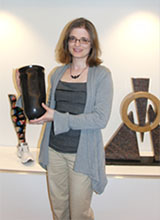


Posted July 9, 2013
Stefania Fatone, Ph.D., Northwestern University, Evanston, Illinois
 Wounded soldiers who have undergone a transfemoral amputation, or amputation above the knee, have lost use of the knee joint. Current transfemoral prosthetic legs include socket designs that engage the pelvis and the hip joint, further limiting both the range of motion and comfort of the amputee. Dr. Stefania Fatone of Northwestern University realized that in order to more fully return wounded soldiers to their previous activity levels, a new socket design that can provide greater freedom of movement for transfemoral amputees is necessary.
Wounded soldiers who have undergone a transfemoral amputation, or amputation above the knee, have lost use of the knee joint. Current transfemoral prosthetic legs include socket designs that engage the pelvis and the hip joint, further limiting both the range of motion and comfort of the amputee. Dr. Stefania Fatone of Northwestern University realized that in order to more fully return wounded soldiers to their previous activity levels, a new socket design that can provide greater freedom of movement for transfemoral amputees is necessary.
Dr. Fatone and her research prosthetist, Mr. Ryan Caldwell, designed a new prosthetic socket that does not impinge on the pelvis when the hip is moved. The new socket is shorter, allowing the muscles to have increased movement without the socket hitting the pelvis. The socket is more flexible and maintains its position by suction from a vacuum pump, increasing the comfort to the soldier.
With funding from a Fiscal Year 2009 Peer Reviewed Orthopaedic Research Program Technology Development Award as well as supplemental funding from the Joint Warfighter Medical Research Program, Dr. Fatone's team manufactured prototype sockets and vacuum pumps and performed initial testing on transfemoral amputee volunteers, who found the new prosthetic to be more comfortable for walking than their previous sockets. Dr. Fatone's team quantified the socket fabrication process in order to fully understand the socket geometry and flexibility aspects, and they are exploring how to further optimize the socket performance.
After the socket performance has been maximized, Dr. Fatone's team plans to produce educational materials so other prosthetists can cast, fit, and fabricate this custom socket for their transfemoral amputee patients. Dr. Fatone hopes that these custom sockets can better serve wounded soldiers wishing to return to the level of activity they enjoyed before their injuries.
Links:
Web Page:
http://www.nupoc.northwestern.edu/research/projects/lowerlimb/dev_subischial.html (external link)














